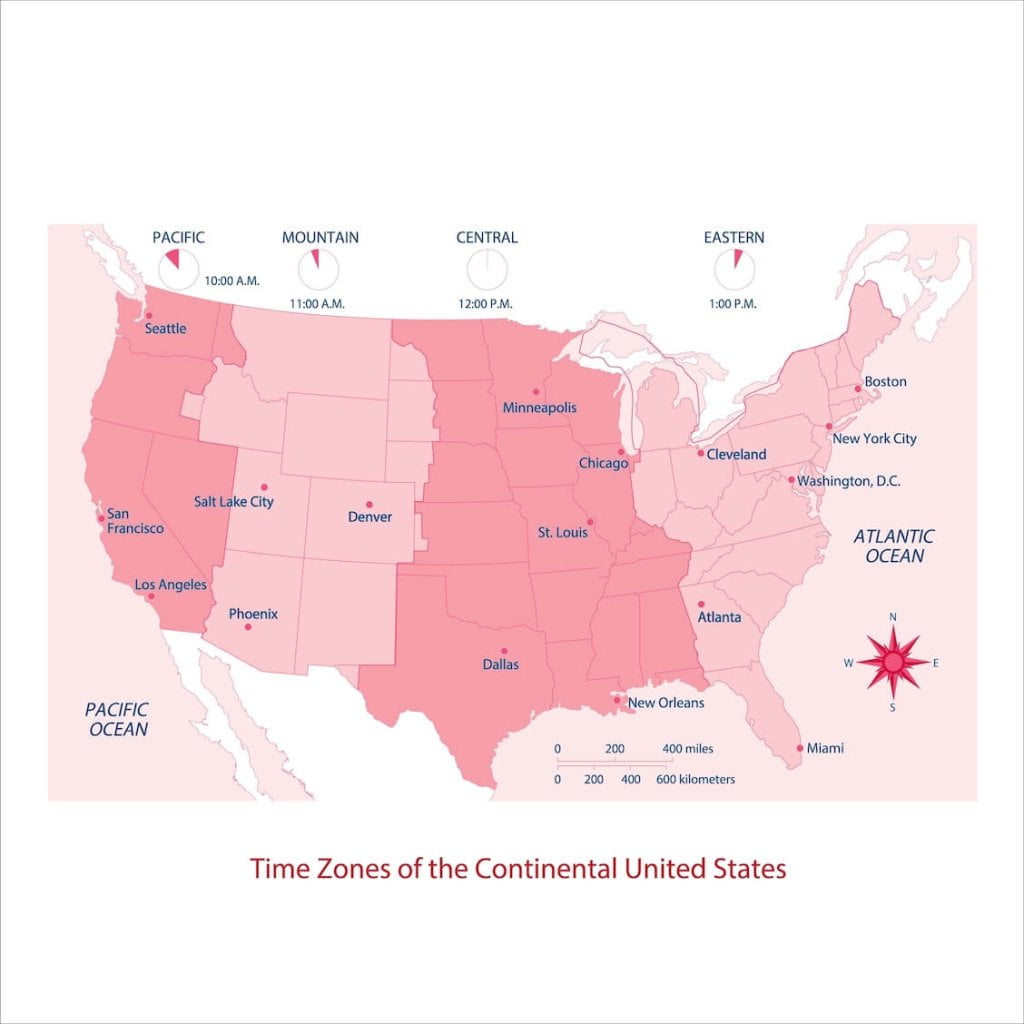Do you often find yourself confused about the time difference between different parts of the United States? Understanding the time zones in the US is crucial for scheduling appointments, making travel plans, and communicating with people in different regions. In this article, we’ll explore the different time zones in the US, how they work, and some useful tips for staying on top of time differences. Whether you’re a traveler, a remote worker, or just curious, read on to learn all about US time zones.
What Are the Time Zones in the US?
The United States spans several time zones, each with its own unique characteristics and impact on daily life. Understanding these time zones is essential for scheduling appointments, making travel plans, and communicating with people in different regions. In this article, we will take a closer look at the six main time zones in the United States, including their boundaries, cities, and other important details.

“Explore the time zones of the United States in our handy guide. From the East Coast to the West Coast, we’ll walk you through the different time zones that shape the nation’s scheduling and daily routines. With Traqq’s insights, learn how to navigate time zone challenges and synchronize schedules seamlessly.”
Eastern Time Zone (ET)
The Eastern Time Zone is the most populous in the United States, covering 17 states and the District of Columbia. It is five hours behind Coordinated Universal Time (UTC-5) during standard time and four hours behind Coordinated Universal Time (UTC-4) during daylight saving time. The Eastern Time Zone includes major cities such as New York, Washington D.C., and Miami.
Central Time Zone (CT)
The Central Time Zone covers 16 states and spans from the Gulf Coast to the Great Lakes. It is six hours behind Coordinated Universal Time (UTC-6) during standard time and five hours behind Coordinated Universal Time (UTC-5) during daylight saving time. The Central Time Zone includes major cities such as Chicago, Dallas, and New Orleans.
Mountain Time Zone (MT)
The Mountain Time Zone covers eight states and spans from the Canadian border to the Mexican border. It is seven hours behind Coordinated Universal Time (UTC-7) during standard time and six hours behind Coordinated Universal Time (UTC-6) during daylight saving time. The Mountain Time Zone includes major cities such as Denver, Salt Lake City, and Phoenix.
Pacific Time Zone (PT)
The Pacific Time Zone covers three states on the West Coast, including California, Oregon, and Washington. It is eight hours behind Coordinated Universal Time (UTC-8) during standard time and seven hours behind Coordinated Universal Time (UTC-7) during daylight saving time. The Pacific Time Zone includes major cities such as Los Angeles, San Francisco, and Seattle.
Alaska Time Zone (AKT)
The Alaska Time Zone covers the state of Alaska and is one hour behind Pacific Time during standard time and the same time as Pacific Time during daylight saving time. It is nine hours behind Coordinated Universal Time (UTC-9) during standard time and eight hours behind Coordinated Universal Time (UTC-8) during daylight saving time. Major cities in the Alaska Time Zone include Anchorage and Juneau.
Hawaii-Aleutian Time Zone (HAT)
The Hawaii-Aleutian Time Zone covers the state of Hawaii and the westernmost portion of the Aleutian Islands. It is ten hours behind Coordinated Universal Time (UTC-10) during standard time and nine hours behind Coordinated Universal Time (UTC-9) during daylight saving time. Major cities in the Hawaii-Aleutian Time Zone include Honolulu and Hilo.
It’s important to note that not all states or regions observe daylight saving time. Arizona, for example, does not observe daylight saving time and stays on Mountain Standard Time year-round. Some areas of Indiana also do not observe daylight saving time. Additionally, some regions of the United States, such as Puerto Rico and the U.S. Virgin Islands, are in different time zones than the mainland United States.
In conclusion, understanding the different time zones in the United States is crucial for scheduling appointments, making travel plans, and communicating with people in different regions. Each time zone has its own unique characteristics and impact on daily life, and it’s important to stay informed and up-to-date on any changes or updates.
How Do Time Zones Work?
Time zones are regions of the Earth where the same standard time is used. They are based on the fact that the Earth rotates 360 degrees every 24 hours, meaning that there are 24 time zones, each covering 15 degrees of longitude.
The International Date Line, which is roughly located at 180 degrees longitude, separates the world into two halves, each with its own set of time zones. When you travel across the International Date Line from west to east, you add a day, and when you travel from east to west, you subtract a day.
The standard time used in a time zone is typically set by the local government or governing body. Daylight saving time, which is the practice of advancing clocks during the summer months to provide more daylight in the evenings, is also used in many regions of the world, including the United States.
When daylight saving time is in effect, the time is set ahead by one hour, meaning that the standard time is one hour ahead of Coordinated Universal Time (UTC). When daylight saving time ends, the time is set back by one hour, meaning that the standard time is one hour behind Coordinated Universal Time (UTC).
It’s important to note that not all regions of the world observe daylight saving time, and some regions have chosen to adopt their own unique time zones based on their specific needs or location.
In conclusion, time zones are based on the Earth’s rotation and are used to standardize time across different regions of the world. Daylight saving time is also used in many regions to provide more daylight in the evenings during the summer months. Staying informed and up-to-date on changes to time zones and daylight saving time is crucial for scheduling appointments, making travel plans, and communicating with people in different regions.
How to Handle Time Zones as a Digital Nomad?
As a digital nomad, managing time zones can be a challenge, but there are ways to work around it. Using a world clock app or website can help you keep track of multiple time zones, while adjusting your calendar to the local time can help you stay organized.
In fact, in the article “The Checklist of a Digital Nomad”, entrepreneur, angel investor, and digital nomad Kartik Garg names time zones as one of the key obstacles to a comfortable nomad life:
Clear communication with clients and colleagues is essential, and tools like time zone converters or meeting schedulers can be useful. When traveling to new time regions, plan ahead and be flexible to accommodate clients or colleagues in different regions.
By following these tips, you can manage time zones effectively and work efficiently no matter where you are.
Related: What Is a Time Zone? A Guide for Digital Nomads
Digital Nomad Friendly Countries Close to United States Time Zones
For digital nomads based in the United States or working with clients and colleagues in the US, it can be helpful to find digital nomad-friendly countries in similar time regions. Here are some countries that are close to the US in terms of time and are known for being friendly to digital nomads:
Mexico – Mexico is a popular destination for digital nomads due to its proximity to the US and similar time zones. Major cities like Mexico City, Cancun, and Puerto Vallarta are all in the Central Time Zone, which makes communication with US clients and colleagues more convenient.
Costa Rica – Costa Rica is located in the Central Time Zone, which makes it a great option for digital nomads working with US clients. The country is known for its natural beauty, friendly locals, and stable political climate, making it a popular destination for digital nomads.
Colombia – Colombia is in the Eastern Time Zone, which is just one hour ahead of Eastern Standard Time. The country is known for its rich culture, friendly people, and affordable cost of living, making it an attractive destination for digital nomads.
Ecuador – Ecuador is located in the Eastern Time Zone, which makes it a convenient option for digital nomads working with US clients. The country is known for its stunning natural beauty, affordable cost of living, and welcoming culture.
Dominican Republic – The Dominican Republic is located in the Atlantic Time Zone, which is just one hour ahead of Eastern Standard Time. The country is known for its beautiful beaches, rich culture, and welcoming locals, making it an attractive destination for digital nomads.
In conclusion, there are several digital nomad-friendly countries close to US time zones, including Mexico, Costa Rica, Colombia, Ecuador, and the Dominican Republic. These countries offer a range of benefits for digital nomads, including convenient location, affordable cost of living, and welcoming cultures.
Use Time Tracking Software to Better Manage Different Time Zones
Time tracking software like Traqq can be a valuable tool for digital nomads, helping you track work hours, manage time more effectively, and stay on top of deadlines.
With Traqq, digital nomads can easily track the time they spend on various tasks and projects, monitor their productivity levels, and generate detailed reports to share with clients or colleagues. This can help digital nomads to stay organized, focused, and productive, even when working remotely or across multiple time regions.
Additionally, Traqq’s features, such as idle time detection and detailed activity tracking, help ensure that clients are billed accurately and that work is completed efficiently.
Another great thing about Traqq is that it lets you easily switch between time regions: you can keep working in the time region of your employer or client or track hours in your own time zone.



